DIEVTURI TIMELINE
1925: Latviešu dievturības atjaunojums (The Renewal of Latvian Dievturība) written by Ernests Brastiņš and Kārlis Bregžis was published.
1926: The Latviešu Dievturu Sadraudze (Community of Latvian Dievturi) was registered as a religious organization.
1932: The Dievturi Catechism Dievturu Cerokslis, written by Ernests Brastiņš, was published.
1931: The most striking example of Dievturi iconography, Dievs, Māra, Laima, was created by painter Jēkabs Bīne.
1928-1929: A magazine Dievturu Vēstnesis (The Dievturi Messenger) was published.
1931-1940: A magazine Labietis (The Noble) was published.
1940 (June 17): The Soviet occupation of Latvia took place, and the Latviešu Dievturu Sadraudze was abolished on August 5.
1940 (July 6): Dievturi leader Ernests Brastiņš was arrested.
1941: The U.S.S.R War Tribunal bestowed the most serious penalty on Ernests Brastiņš, he was to be shot.
1956: The Dievturi in exile recommenced publishing the magazine Labietis.
1979: Dievsēta (God’s Yard) was built in Wisconsin (U.S.).
1990: The Dievturu Sadraudze (Community of Dievturi) was officially registered in Latvia as a religious organization.
FOUNDER/GROUP HISTORY
In Latvia, there are persons undertaking activities who call themselves pagans and who maintain that the Latvian traditional religion has survived until today: Dievturi (plural), Dievturis (singular) – “God keeper.” Latvian paganism, or Dievturība, can be considered to be a reconstructionist movement focusing great attention on history, which considers that the archaic religion can be reconstructed by studying folklore, folk traditions, archaeology etc.
The origins of the idea to reconstruct the Latvian traditional religion stretch back to the mid-nineteenth century, when representatives of Latvian national romanticism created the first ancient Latvian pantheon of gods. An article by Juris Alunāns’ (1832-1864) “Dievi un gari, kādus vecie latvieši citkārt cienījuši” (Gods and Spirits Respected by Ancient Latvians in the Past), where the author listed about twenty deities, was published in the Mājas Viesis newspaper in 1858 (Alunāns 1858). Alongside the ancient Latvian deities of Saule, Laima, Mēness and Pērkons, there was also mention of the romanticized Anšlavs and Pramšāns, as well as Potrimps and Pakuls borrowed from ancient Prussian sources. Even though the poet Auseklis (1850-1879) added to this list and sorted all the deities into a hierarchic table, the activities of the national romanticists were not crowned by the revival of paganism in Latvia.
The history of Dievturība began in the 1920s, shortly after the proclamation of the Republic of Latvia (1918), when a brochure Latviešu dievturības atjaunojums: Šaurs vēstures, gudrības and daudzinājuma apraksts (Revival of the Latvian Dievturi Religion: A Narrow Description of History, Wisdom and the Way of Exaltation) (1925) by artist Ernests Brastiņš’ (1892-1942) and engineer Kārlis Marovskis-Bregžis (1885-1958) came out (Brastiņš and Bregžis 1925). In 1926, the registered certificate for the Latviešu Dievturu Sadraudze (Community of 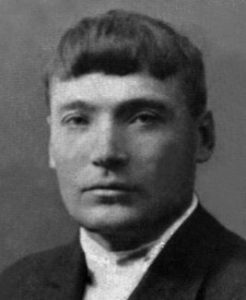 Latvian Dievturi) was issued to Kārlis Marovskis-Bregžis, but not long afterwards, a schism took place in the movement (Misāne 2005). In 1927, another Dievturi organization was registered, which was headed by Ernests Brastiņš. [Image at right] Each group published its own magazine: Marovskis-Bregžis was the editor of Dievturu Vēstnesis (The Dievturi Messenger) (1928-1929), while Brastiņš’ group published the Labietis (The Noble) (1931-1940) magazine. The groups grew apart as Marovskis-Bregžis did not hold out hope that Dievturība could become the religion of all the Latvian people and considered that the ancient religion should be practiced within the family and in small communities. He also consistently objected to the involvement of Dievturi in politics. Brastiņš, in contrast, had great ambitions, which included political ones. As his group was notable for social activism and the capacity to attract well-known people in society to the group, Brastiņš, specifically, is generally considered to be the founder of the Dievturi movement in Latvia.
Latvian Dievturi) was issued to Kārlis Marovskis-Bregžis, but not long afterwards, a schism took place in the movement (Misāne 2005). In 1927, another Dievturi organization was registered, which was headed by Ernests Brastiņš. [Image at right] Each group published its own magazine: Marovskis-Bregžis was the editor of Dievturu Vēstnesis (The Dievturi Messenger) (1928-1929), while Brastiņš’ group published the Labietis (The Noble) (1931-1940) magazine. The groups grew apart as Marovskis-Bregžis did not hold out hope that Dievturība could become the religion of all the Latvian people and considered that the ancient religion should be practiced within the family and in small communities. He also consistently objected to the involvement of Dievturi in politics. Brastiņš, in contrast, had great ambitions, which included political ones. As his group was notable for social activism and the capacity to attract well-known people in society to the group, Brastiņš, specifically, is generally considered to be the founder of the Dievturi movement in Latvia.
The most visible ideologue of Dievturība, Latvian painter and publicist Ernests Brastiņš (1892-1942) had studied drawing in St. Petersburg (1911-1916). After the end of the First World War, he took part, as an officer, in the Latvian Battles for Independence which ended in 1920. He worked at the Latvian War Museum and was also a teacher at the City of Rīga’s Technical Drawing and Art School (Rožkalne 2003). When exhibiting his works from 1917, he always selected paintings about ancient times in Latvia. The other most active representatives of the Dievturi in the 1920s-1930s were painter Jēkabs Bīne (1895-1955), writers Voldemārs Dambergs (1886-1960), Viktors Eglītis (1877-1945) and Juris Kosa (1878-1967), literary historian and critic Alfrēds Goba (1889-1972), and composers Jānis Norvilis (1906-1994) and Artūrs Salaks (1891-1984).
The Marovskis-Bregžis group was focused on individual religious experience, whereas the Brastiņš group aimed at realizing broad socio-cultural changes. To achieve these, Brastiņš and his confederates sought allies in politics and developed contacts with the Pērkonkrusts (Thunder Cross) organization, which popularized Latvian nationalist ideology (Stasulane 2013). After the official annexation of Latvia by the Soviet Union on August 5, 1940, all societies, including the Latvijas Dievturu Sadraudze, were closed down. In this way, the activities of the pagans in Latvia were officially discontinued, but this was only one episode in a string of repressions which affected the Dievturi. Already on July 6, 1940, Ernests Brastiņš was arrested. As the organizer and leader of the Dievturu 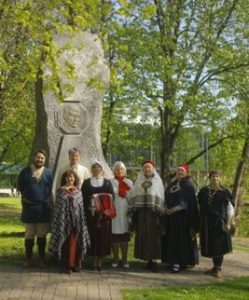 Sadraudze, he was sentenced to eight years of imprisonment at a labor camp on May 24, 1941. During his imprisonment in Russia, he was repeatedly tried, and on December 27, 1941, the U.S.S.R War Tribunal imposed the most serious penalty on Brastiņš. He was sentenced to be shot, and this penalty was also carried out. [Image at right]
Sadraudze, he was sentenced to eight years of imprisonment at a labor camp on May 24, 1941. During his imprisonment in Russia, he was repeatedly tried, and on December 27, 1941, the U.S.S.R War Tribunal imposed the most serious penalty on Brastiņš. He was sentenced to be shot, and this penalty was also carried out. [Image at right]
The Soviet authorities did not consider the Dievturi to be political opponents of serious note, and therefore, sentenced to death only the leader of the group. The persecution and repressions experienced by the Dievturi after the Second World War can be characterized as the forcible imposition of communist ideology, the requirement to glorify the Soviet authorities and restriction of freedom of speech (Stasulane and Ozoliņš 2017). The repressive Soviet regime suppressed the attempts of the Dievturi to reconstruct the ancient Latvian religion and to give it the functions of a national religion (Beitnere 1995).
In the 1960s, the Dievturi recommenced their activities in exile: initially in Germany and Great Britain, while later, the most active Dievturi congregations were in Chicago (U.S.) and Toronto (Canada), and even in Australia (Jātniece 2004). In exile, the Dievturi recommenced issuing Labietis (1956) magazine, which was sent to various countries. Dievturi activities in exile were led by artist Arvīds Brastiņš (1893-1984), who continued what his brother Ernests Brastiņš had begun and assumed duties as editor of Labietis magazine. In 1979, Dievsēta (God’s Yard), which is the only Dievturi property outside of Latvia, was built near Tomah, Wisconsin (U.S.). American Latvians celebrate traditional Latvian celebrations there eight times a year.
In Latvia, the Dievturi movement, based on the folklore movement, only recommenced its activities gradually in the late 1980s (Kursīte 1990). Folklore groups were sometimes formally included in the family of Dievturi, even though only a few of their participants had a deeper interest in the religious aspects of Dievturība. The Dievturu Sadraudze was only officially renewed as a religious organization in 1990, and its activities were headed by ceramicist Eduards Detlavs (1919–1992).
After Latvia regained its independence (1990), the return of Dievturi from exile was a significant catalyst for the revival of Dievturība in Latvia. Several of them regained property which had been nationalized after the Second World War and formed small groups of Dievturi. The financial support which they provided funding the celebration of Latvian traditional festivals, not only for their own groups, but also to schools, was also important 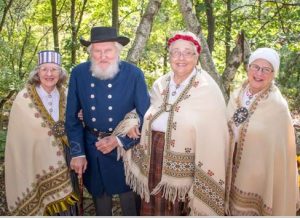 The Dievturi from exile, especially the older generation, [Image at right] held strongly onto the views of E. Brastiņš’ era, and did not notice that the ideas they had been preserved in exile could no longer function in contemporary Latvia. The desire of the Dievturi who had returned from exile, to lead and impose their views on Latvia’ Dievturi, was not acceptable to everyone. For this reason, many notable leaders and participants in folklore groups declined to collaborate with the Dievturi. The folklore groups found the demands of the Dievturi from exile to allocate religious status to Dievturība, and their claims to be the only true interpreters of the folk traditional culture, to be unacceptable. In the 1990s, the leading Dievturi were unable to change or develop a doctrine which could attract the interest of young people and the media. The conservative branch, which strongly held onto the teachings of E. Brastiņš, dominated the Latvian pagan environment. Even if lip service was paid to the need for changes, their introduction took place slowly in reality. This type of conservatism was alienating, and many of those who had been involved in the Dievturi movement in the late 1980s, moved away from it.
The Dievturi from exile, especially the older generation, [Image at right] held strongly onto the views of E. Brastiņš’ era, and did not notice that the ideas they had been preserved in exile could no longer function in contemporary Latvia. The desire of the Dievturi who had returned from exile, to lead and impose their views on Latvia’ Dievturi, was not acceptable to everyone. For this reason, many notable leaders and participants in folklore groups declined to collaborate with the Dievturi. The folklore groups found the demands of the Dievturi from exile to allocate religious status to Dievturība, and their claims to be the only true interpreters of the folk traditional culture, to be unacceptable. In the 1990s, the leading Dievturi were unable to change or develop a doctrine which could attract the interest of young people and the media. The conservative branch, which strongly held onto the teachings of E. Brastiņš, dominated the Latvian pagan environment. Even if lip service was paid to the need for changes, their introduction took place slowly in reality. This type of conservatism was alienating, and many of those who had been involved in the Dievturi movement in the late 1980s, moved away from it.
At the beginning of the new millennium, sixteen pagan groups (Auseklis, Rāmava, Burtnieks, Dainu Līga, Daugava, Tālava, Beverīna, Namejs, Madaras, Rūsiņš, Dižozols, Bramaņi, Viesturs, Sidrabene, Austra and Māras loks) were active in Latvia. Of these, the majority had joined the Latvijas Dievturu Sadraudze, whereas some operated as independent groups and did not even register their activity. Currently, paganism in Latvia is a socially uninfluential and fragmented movement.
DOCTRINES/BELIEFS
Latvian traditional culture is the source for Dievturi doctrine: folklore, especially folk songs (dainas), and customs. Brastiņš compiled selections of Latvian folk songs Latvju Dieva dziesmas (Songs of the Latvian God) (Brastiņš 1928), Latviešu tautasdziesmu tikumi (Morals in Latvian Folk Songs) (Brastiņš 1929a) and Latvju gadskārtu dziesmas (Latvian Annual Songs) (Brastiņš 1929b), which tend to be called the holy scriptures of the Dievturi. However, most Dievturi consider the aggregate of all Latvian folk songs to be sacred texts, as issued and arranged (in six volumes / eight tomes between 1894 and 1915) by folklore collector Krišjānis Barons (1835-1923). To reconstruct the system ancient Latvian religion, Brastiņš composed even a short Catechism Dievtuŗu Cerokslis (Brastiņš 1932).
Currently, Dievturība includes within it a sufficiently broad and diverse gamma of views, which does not allow for paganism to be considered a unified representation of Latvian religious experience and lifestyle. The account of Dievturi teachings, which can be found on the Latviešu Dievturu Sadraudze home page, begins with an explanation of what God is (“Dievturība” 2020): the source and cause of everything, the World’s Soul, the creator of the world and man, the determiner of laws, the defender of legal process, the past, the existing and the enduring. Pērkons (Thunder) is mentioned as the direct expression of the presence of God, the main provider of justice, order and movement in the world, and fertility too. Laima, who twists, spins and leads the thread of life, health and prosperity, is mentioned as the determiner of people’s destiny according to God’s laws. Laima represents the dimension of time, while Māra represents the three 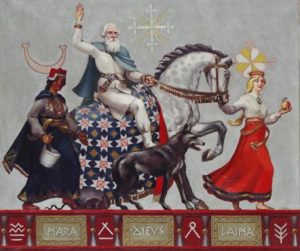 spatial dimensions of the physical world (Biezais 1992). Dievs, Laima and Māra are three godly creatures who are portrayed in the most striking example of Dievturi iconography, a painting Dievs, Māra, Laima (1931) created by painter Jēkabs Bīne (1895-1955) (Ogle 2013). [Image at right]
spatial dimensions of the physical world (Biezais 1992). Dievs, Laima and Māra are three godly creatures who are portrayed in the most striking example of Dievturi iconography, a painting Dievs, Māra, Laima (1931) created by painter Jēkabs Bīne (1895-1955) (Ogle 2013). [Image at right]
Members of today’s Dievturi movement emphasize that Dievturība is a renewal of the Latvian worldview framed in folk songs. This is because the main source of theoretical interpretation for Latvia’s pagans is Latvian folklore, especially folk songs, while religious practice is created, based on evidence of the Latvian traditional way of life, being mainly ethnographic descriptions. Despite the references to Latvian folklore and ethnography, the movement’s leaders offer a creative interpretation. However, even while looking at new and more modern ways of interpretation, contemporary pagans are uncritically adopting Dievturi concepts from the 1920s–1930s and derive their traditions from the assumptions of the originators of the movement.
RITUALS/PRACTICES
Daudzināšana (Exaltation) is the main ritual undertaken by Dievturi (Ozoliņš 2010). Usually this is dedicated to some deity (Dievs, Pērkons, Māra, Laima etc.) and is undertaken at a specific time in the pagan religious calendar (annual festivities and solstices: Ziemas Saulgrieži [Winter Solstice] and Vasaras Saulgrieži [Summer Solstice] etc.) and at some special site (ancient Baltic hillforts, cult hills, cult groves, cult trees, cult springs, heaps of stones, great stones, etc).
The most active exaltations by Dievturi are organized once a month. They are an open event which can be attended by members of other groups and those who are interested in Latvian traditional culture, including relatives, friends and neighbors of Dievturi. Dievturi also perform rituals which are connected with the passage of people’s lives: naming ceremony (pādītes dīdīšana), marriage (kāzas) and funerals (bēres).
The rituals, which are performed outside, take place near springs, stones, trees (oaks in particular), and their most important component is fire, the symbol of light/sun. Even though this is not mandatory, most participants in the rituals usually wear Latvian traditional costume (a sagša or woolen wrap, waistband, hat, linen shirt, trousers and waistcoat, brooches, rings, pendants, amber beads, wreaths, etc.). An important component of the rituals is the singing of folk songs, Latvian folk dancing and dancing games accompanied by traditional musical instruments (the kokle, cītara, stabule, dūdas, bungas etc.). Food is also on offer but is not woven into the ritual’s sacred part. Ritual participants sit at a table which is decorated with ferns, daisies, corn flowers and oak twigs. The most popular dishes are rye bread, honey, cheese, cottage cheese, meat pies, spring water, milk, and beer.
There is currently a trend for seeking new ideas for developing and popularizing pagan concepts, which is why Dievturība is characterized by the entry of creative ideas (Ozoliņš 2013) that are expressed as the rediscovery of culturally and historically significant objects, including pagan cultic places. The phenomenon of new sacred sites in Latvia flourished in the late 1980s and the early 1990s, at a time when Latvia was on the path to regaining its independence. It stimulated searches for Latvian identity when official atheism was rapidly being replaced by religious pluralism.
Pokaiņi, which is located in the Zemgale region not far from the City of Dobele, is the most widely known new Latvian sacred site (Muktupāvela 2013). Pokaiņi Forest has become famous for its piles of stones: many people feel peculiar flows of energy from the concentration of stones of various sizes and forms in this place: some see visions, while others detect a flow of information. Pokaiņi was already talked about widely in the 1930s, although a full-fledged discovery of the place did not occur until the 1990s. Pokaini Forest then became a place of pilgrimage for many tourists attracted by rumors about the healing power of this place. A number of implausible explanations and bizarre assumptions have been created about the Pokaiņi stones: healing power has been attributed to the stones (some cure joint diseases, some cure osteochondrosis, and some others cure gynecological diseases). It is voiced that Pokaiņi was a meeting place of thirty druids, where each druid controlled the weather from his own hill. Another legend says that some strange object is hidden under one of the rocks. Some say it is a radioactive meteorite; some are convinced it is an ancient tomb. Guides talk about anomalies in natural phenomena that have been observed, while New Age type spiritual mentors and healers consider Pokaiņi to be the sacred center of the ancient Latvian civilization.
The Lokstene sacred site was inaugurated on an island on the River Daugava in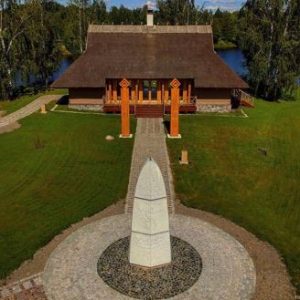 2017. The initiator and implementer of the new sacred place was an entrepreneur and the idea of building Dievsēta (God’s Yard) came to him in a dream. [Image at right] The sacred building was built in an east-west direction with symbols of the Moon at the ends of the roof, while the main entrance was located on the southern side. Entry to the sacred place is through the gates of the Sun (two poles with symbols of the sun at their apex). A four-meter-high stone spire created by a sculptor is located in the courtyard of the shrine, (constructed from three processed granite sections, symbolizing the heavens, the land and the underworld).The Latvijas Dievturu Sadraudze occupies the sacred place and undertakes rituals there and does not want Dievsēta to be transformed into a place for public tourism.
2017. The initiator and implementer of the new sacred place was an entrepreneur and the idea of building Dievsēta (God’s Yard) came to him in a dream. [Image at right] The sacred building was built in an east-west direction with symbols of the Moon at the ends of the roof, while the main entrance was located on the southern side. Entry to the sacred place is through the gates of the Sun (two poles with symbols of the sun at their apex). A four-meter-high stone spire created by a sculptor is located in the courtyard of the shrine, (constructed from three processed granite sections, symbolizing the heavens, the land and the underworld).The Latvijas Dievturu Sadraudze occupies the sacred place and undertakes rituals there and does not want Dievsēta to be transformed into a place for public tourism.
ORGANIZATION/LEADERSHIP
The Latvijas Dievturu sadraudze is a religious non-profit organization, the spiritual leader of which is Valdis Celms (Zinību padomes priekšsēdis — Chairman of the Knowledge Board), while the organizational leader is Andrejs Broks (dižvadonis – the Great Leader). There are nine people on the board of the organization who regulate the relationships between eight groups (Auseklis, Beverīna, Dainu līga, Daugava, Pērkons, Rāmava, Rūsiņš and Svēte), which currently constitute the Latvijas Dievturu sadraudze.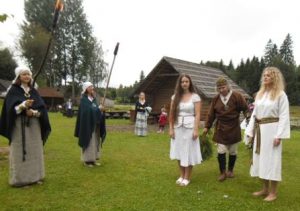 Adults of sound mind, who have no other religious affiliation and endeavor to acknowledge the core values of the Latvian religion in their lives, and Dievturi events, can be admitted to the groups which make up the Latvijas Dievturu Sadraudzība. They are the legal members of the organization, savieši (“our people”). [Image at right] Even though people who belong to another religion are permitted to be members of the groups which comprise the Latvijas Dievturu Sadraudzība, they are only given the status of labvēlis (“patron”) and cannot be elected to positions as organizational leaders. On joining the Latvijas Dievturu Sadraudzība, savieši and labvēļi fill in a form, receive a symbol signifying their belonging to it and pay an annual membership fee. The savieši general meeting determines the amount and the method for payment.
Adults of sound mind, who have no other religious affiliation and endeavor to acknowledge the core values of the Latvian religion in their lives, and Dievturi events, can be admitted to the groups which make up the Latvijas Dievturu Sadraudzība. They are the legal members of the organization, savieši (“our people”). [Image at right] Even though people who belong to another religion are permitted to be members of the groups which comprise the Latvijas Dievturu Sadraudzība, they are only given the status of labvēlis (“patron”) and cannot be elected to positions as organizational leaders. On joining the Latvijas Dievturu Sadraudzība, savieši and labvēļi fill in a form, receive a symbol signifying their belonging to it and pay an annual membership fee. The savieši general meeting determines the amount and the method for payment.
ISSUES/CHALLENGES
The emergence of Dievturība in Latvia in the 1920s came about through attempts to create an alternative religion to Christianity (Shnirelman 2002) and was facilitated by two important factors. Firstly, the Latvian Evangelical Lutheran Church’s took a negative stance against the 1905 Revolution. As a result of this, Lutheran priests came to be viewed as enemies of the people and Christianity was treated as a religion forced on the Latvians through “fire and the sword,” Paganism was, therefore, an unknown phenomenon in Latgale in the first half of the twentieth century, as this was the Latvian territory where Catholicism was dominant. Representatives from the Latvian Evangelical Lutheran Church were also the most active combatants against the Dievturi, and strongly objected to the strategic goal of the pagans, to achieve the recognition of the reconstructed Latvian traditional religion as the state religion. As Dievturība was created as an alternative to Christianity, even today Dievturi stress that Christianity should give up its status to Dievturība as the only true religion in Latvia. Dievturi emphasize that the Christian church’s influence in politics ensures its dominance in the social sphere, starting from national and local government institutions to the media, schools and medical institutions.
Secondly, through its proposal for a Latvian national religion, the Dievturi fitted in with nationalist politics prevalent in Europe in the first half of the twentieth century (Misāne 2000). Nowadays too, Dievturība is characterized by a powerful ethnic dimension (Stasulane 2019). However, the leading role of Latvians is not emphasized, as it is considered that each people have their own land, language and traditions. Highlighting tolerance towards the cultural values of all people and the peaceful coexistence of various peoples, participants in Dievturi groups express an important point of view in Latvian society. However, Latvianness is an important concept and all Dievturi activities are subordinate to it: the rituals, cultural-historical excursions, gatherings to clean up sacred sites, folklore events, articles in the press, media interviews, thematic summer camps, and the celebration of Latvian national celebrations and the most important remembrance days.
The contemporary neo-pagan movement in Latvia is characterized by conflicting aspects. On the one hand, in pagan activities, a desire is expressed to juxtapose oneself and one’s national views against globalization trends, which do not conform to the unhurried and contemplative lifestyle of traditional cultures. On the other hand, the latest trends reveal that in Latvia too, paganism is following a similar trajectory to Anglo-American paganism. Respectively, it is gaining New Age features: scientific terminology and a self-reflexive character is entering pagan discourse. In the near future, paganism in Latvia is dependent on its capacity to respond to the challenges of the era. However, looking further into the future, there is some doubt about the existence of “traditional” Dievturība as something that is capable of survival. This is because Dievturi currently exist on the periphery of social life in Latvia and are providing vitally important answers only to members of the movement. They have never exceeded a thousand members, and there are currently only a few hundred.
IMAGES
Image #1: Ernests Brastiņš, the founder of the Dievturi Movement (1892-1942). Accessed from http://garamantas.lv/lv/person/873122/Ernests-Brastins.
Image #2: Dievturi next to the memorial to Ernests Brastiņš (unveiled in 2007, authors: Uldis Sterģis, Jānis Strupulis and Teodors Nigulis) in Rīga at Kronvalda Park. Accessed from http://dievturi.blogspot.com/.
Image #3: Dievturi in exile (from left): Lilita Spura, Ričs Spura, Ilze Kļaviņa and Elga Pone. Accessed from http://latviannewspaper.com/raksti/rakstsFoto.php?kuraFoto=14682&KursRaksts=7520.
Image #4: Jēkabs Bīne. Dievs, Māra, Laima painting (1931). Exhibited at the Latvian National Museum of Art. Accessed from https://www.delfi.lv/news/latvijas-makslai-200/maksla-un-varas-simboli.d?id=49177559.
Image #5: Lokstene Shrine (Dievsēta- God’s Yard) on Liepsala in Klintaine Parish. Accessed from https://www.la.lv/uz-salas-daugava-atklata-dievturu-svetnica.
Image #6: The admission ritual for new savieši (2013) at Ate Windmill. Accessed from http://dievturi.blogspot.com/2013/08/musu-jaunas-labietes.html.
REFERENCES
Alunāns, Juris. 1858. “Deewi un garri, kahdus weccee Latweeschi citkahrt ceenijuschi”. Mahjas Weesis 48:6-8.
Beitnere, Dagmāra. 1995. “Lettische heidnische Religion als Vertreterin des Religiosen Synkretismus.” Annals of the European Academy of Sciences and Arts 15:42–50.
Biezais, Haralds. 1992. Dievturi – nacionālie romantiķi – senlatvieši. Ceļš 1:43–60.
Brastiņš, Ernests. 1932. Dievtuŗu Cerokslis jeb Teoforu Katķisms tas ir senlatviešu dievestības apcerējums. Rīga: Grāmatu Draugs.
Brastiņš, Ernests. 1929a. Latviešu tautasdziesmu tikumi. Rīga: Dievturu draudze.
Brastiņš, Ernests. 1929b. Latvju gadskārtas dziesmas. Rīga: Latvju Dievturu draudze.
Brastiņš, Ernests. 1928. Latvju Dieva dziesmas. Rīga: Latvju Dievturu draudze.
Brastiņš, Ernests, and Kārlis Bregžis. 1925. Latviešu dievturības atjaunojums: Šaurs vēstures, gudrības un daudzinājuma apraksts. Rīga.
“Dievturība.” Accessed from http://dievturi.blogspot.com/p/dievturiba.html on 8 February 2020.
Jātniece, Amanda Zaeska. 2004. “Dievturu iespaids latvietības uzturēšanā trimdā.” Pp. 345–53 in Trimda, kultūra, nacionālā identitāte, edited by Daina Kļaviņa and Māris Brancis. Rīga: Nordik.
Kursīte, Janīna. 1990. “Dievturi un latviešu folkloras pētniecība.” Literatūra un Māksla 19:12.
Misāne, Agita. 2000. “The Traditional Latvian Religion of Dievturība in the Discourse of Nationalism.” Humanities and social sciences. Latvia. Religius minorities in Latvia 4:32–53
Misāne, Agita. 2005. “Dievturība Latvijas reliģisko un politisko ideju vēsturē.” Reliģiski-filozofiski raksti 10:101–17.
Muktupāvela, Rūta. 2013. “The Mythology of Ethnic Identity and the Establishing of Modern Holy Places in Post-Soviet Latvia.” Pomegranate: The International Journal of Pagan Studies 14:69-90.
Ogle, Kristīne. 2013. “Representation of Nature Spirits and Gods in Latvian Art in the First Half of Twentieth Century.” Pomegranate: The International Journal of Pagan Studies 14:47–68.
Ozoliņš, Gatis. 2013. “The Dievturi Movement in Latvia as Invention of Tradition.” Pp. 94–112 in Modern Pagan and Native Faith Movements in Central and Eastern Europe, edited by Kaarina Aitamurto and Scott Simpson. Durham: Acumen.
Ozoliņš, Gatis. 2010. “Contemporary “Dievturi” Movement in Latvia: Between Folklore and Nationalism.” Grupės ir Aplinkos 2:99-104.
Rožkalne, Anita. 2003. “Brastiņš Ernests.” Pp. 99 in Latviešu rakstniecība biogrāfijās, edited by Anita Rožkalne. Rīga: Zinātne.
Shnirelman, Victor A. 2002. “Christians! Go home: A Revival of Neo-Paganism between the Baltic Sea and Transcaucasia.” Journal of Contemporary Religion 17: 197-211.
Stasulane, Anita. 2019. “A Reconstructed Indigenous Religious Tradition in Latvia.” Religions 10:1-13.
Stasulane, Anita. 2013. “The Dievturi Movement in the Reports of the Latvian Political Police.” Pomegranate: The International Journal of Pagan Studies 14:31–46.
Stasulane, Anita, and Gatis Ozoliņš. 2017. “Transformations of Neopaganism in Latvia: From Survival to Revival.” Open Theology 2:235-48.
Publication Date:
25 April 2020
